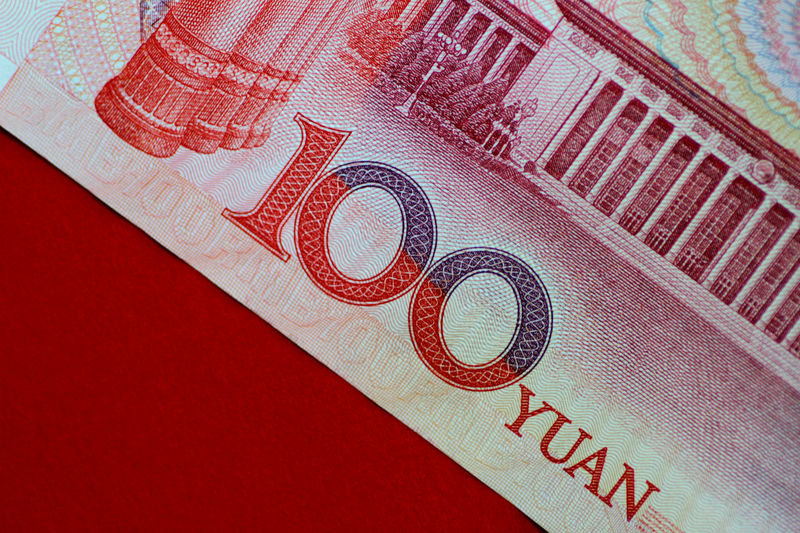 © Reuters. FILE PHOTO: Illustration photo of a China yuan note
© Reuters. FILE PHOTO: Illustration photo of a China yuan noteSHANGHAI (Reuters) – China’s yuan currency edged lower on Tuesday after U.S. President Donald Trump said Washington will impose duties on an extra $200 billion worth of Chinese imports, sharply escalating the trade fight between the two economic giants.
But Chinese stocks bounced in afternoon trading, after a wobbly early session, led by a rally in infrastructure stocks, with some betting that Beijing will step up investment in roads and bridges to offset the impact of the latest tariff salvo from Trump, much of which has already been priced in by the markets.
Trump on Monday imposed 10 percent tariffs on about $200 billion worth of Chinese imports, and threatened to levy duties on an additional $267 billion of Chinese goods if Beijing retaliates.
Chinese Vice Premier Liu He is set to convene a meeting in Beijing on Tuesday morning to discuss the government’s response to the U.S. decision, Bloomberg News reported, citing a person briefed on the matter.
After trading sideways in the morning session, China’s blue-chip CSI300 index () rose 1.3 percent to 3,245.83 points at 6:03 GMT, while the Shanghai Composite Index () gained 1.1 percent to 2,680.99 points.
In Hong Kong, the Hang Seng index () dropped 0.1 percent, to 26,898.33 points, having recovered much of early losses. The Hong Kong China Enterprises Index () gained 0.3 percent, to 10,491.65.
“The fresh U.S. measures are fully within expectations,” said Wen Feng, investment manager at hedge fund house Shanghai V-Invest Co Ltd.
“China has suffered worse hardships in the past, and I believe some Chinese companies will emerge out of trade war much stronger.”
Still, he suggested investors avoid sectors most vulnerable to trade disputes, such as electronics and machinery, as market sentiment will likely remain subdued for some time.
Indeed, with around a 20 percent loss so far in 2018, Shanghai’s stock market has joined the crisis-hit trio of Turkey, Argentina and Venezuela among the world’s four worst performers. Besides the headline drop in share values, China’s currency has fallen sharply and share transaction volumes have shrunk.
“After benefiting from persistent upgrades for almost two years, China is now starting to witness downgrades,” CLSA wrote in a research note on Tuesday, referring to earnings forecasts.
The brokerage identified several sectors most affected by the proposed U.S. tariffs, including electrical machinery and equipment, machinery, furniture, vehicles, and optical instruments.
Chinese infrastructure stocks .CSI300II> jumped over 2 percent in afternoon trading, reflecting hopes that Beijing will accelerate investment on tollways and bridges to counter the negative impact from trade frictions.
That optimism quickly spread to other sectors in China.
Technology .CSIINT> and consumer discretionary stocks (), which were among the worst performers in morning trading, also reversed losses.
YUAN DIPS
The yuan dipped slightly against the dollar.
Prior to the market opening, the People’s Bank of China (PBOC) set the midpoint rate
The spot market
Traders said the renewed Sino-U.S. trade tension piled pressure on the yuan, but market participants refrained from aggressively testing lows for fear the authorities may quickly step in.
Investors were “spontaneously” liquidating their short yuan positions, which lifted the offshore yuan from its intraday low, said a trader at a Chinese bank.
“Market will watch out for China’s possible reaction to the new round of trade tariffs. China is likely to reject the invitation from the U.S. Treasury for the new round of trade talk,” OCBC Bank said in a note on Tuesday.
Liu Li-gang, chief China economist at Citi said in a note to clients that the yuan might face more downside pressure.
“The risk and the sluggish domestic demand may exert depreciation pressure on the RMB, which may partly offset the tariff impact.”
He said China’s best policy option was to “accelerate domestic reforms and grow out of the tariff war”.
Source: Investing.com




























